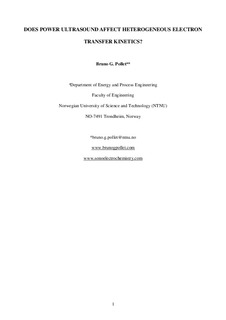| dc.contributor.author | Pollet, Bruno | |
| dc.date.accessioned | 2019-05-09T11:27:10Z | |
| dc.date.available | 2019-05-09T11:27:10Z | |
| dc.date.created | 2019-02-18T07:57:28Z | |
| dc.date.issued | 2018 | |
| dc.identifier.citation | Ultrasonics sonochemistry. 2019, . | nb_NO |
| dc.identifier.issn | 1350-4177 | |
| dc.identifier.uri | http://hdl.handle.net/11250/2597112 | |
| dc.description.abstract | Most of the observations seen in the application of power ultrasound in electrochemistry or also known as
sonoelectrochemistry are due to enhanced mass-transport of electroactive species from the bulk solution to the electrode surface caused by efficient stirring, acoustic streaming and cavitation. However, fundamental studies on the effect of ultrasound on electrode kinetics i.e. on the electron-transfer are scarce. The main question still remains to be answered:Does power ultrasound affect heterogeneous electron transfer kinetics? This opinion paper discusses the effect of ultrasonic frequency and intensity upon the electrode kinetic parameters such as the half-wave potential (E1/2) and the apparent heterogeneous rate constant (ko). A few sonoelectrochemical studies have highlighted changes in half-wave potential and in apparent heterogeneous rate constant for both quasi-reversible and irreversible systems when the data were compared to silent conditions. These observations are thought to be due to the contribution of mass-transport and macroscopic temperature effects, as well as the continuous cleaning of the electrode surface caused by the collapse of high-energy cavitation bubbles and the production of high velocity jets of liquid. However, there still remains mechanistic controversy in assigning whether these findings could also be due to localised temperature increases, the contribution of sonolysis products or solely due to enhanced mass-transport at the electrode surface. Thus, the effect of stirring, macroscopic temperature and sonication time upon these electrode kinetic parameters is also shown
to be important factors in comparing the validity of any sonoelectrochemical effects. | nb_NO |
| dc.language.iso | eng | nb_NO |
| dc.publisher | Elsevier | nb_NO |
| dc.rights | Attribution-NonCommercial-NoDerivatives 4.0 Internasjonal | * |
| dc.rights.uri | http://creativecommons.org/licenses/by-nc-nd/4.0/deed.no | * |
| dc.title | Does power ultrasound affect heterogeneous electron transfer kinetics? | nb_NO |
| dc.type | Journal article | nb_NO |
| dc.type | Peer reviewed | nb_NO |
| dc.description.version | acceptedVersion | nb_NO |
| dc.source.pagenumber | 7 | nb_NO |
| dc.source.journal | Ultrasonics sonochemistry | nb_NO |
| dc.identifier.doi | 10.1016/j.ultsonch.2018.12.017 | |
| dc.identifier.cristin | 1678106 | |
| dc.description.localcode | © 2018. This is the authors’ accepted and refereed manuscript to the article. Locked until 31.12.2020 due to copyright restrictions. This manuscript version is made available under the CC-BY-NC-ND 4.0 license http://creativecommons.org/licenses/by-nc-nd/4.0/ | nb_NO |
| cristin.unitcode | 194,64,25,0 | |
| cristin.unitname | Institutt for energi- og prosessteknikk | |
| cristin.ispublished | true | |
| cristin.fulltext | original | |
| cristin.qualitycode | 1 | |

